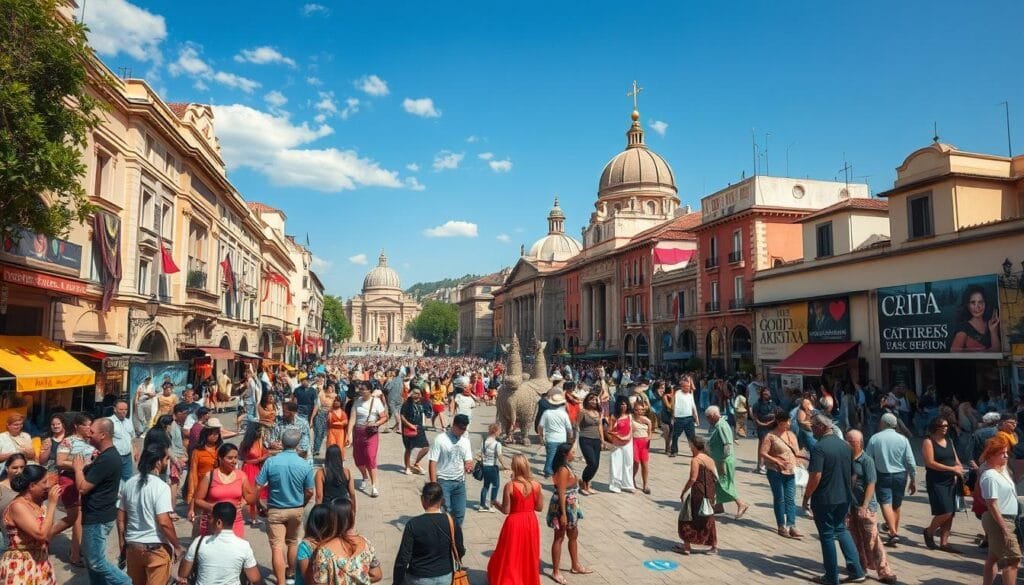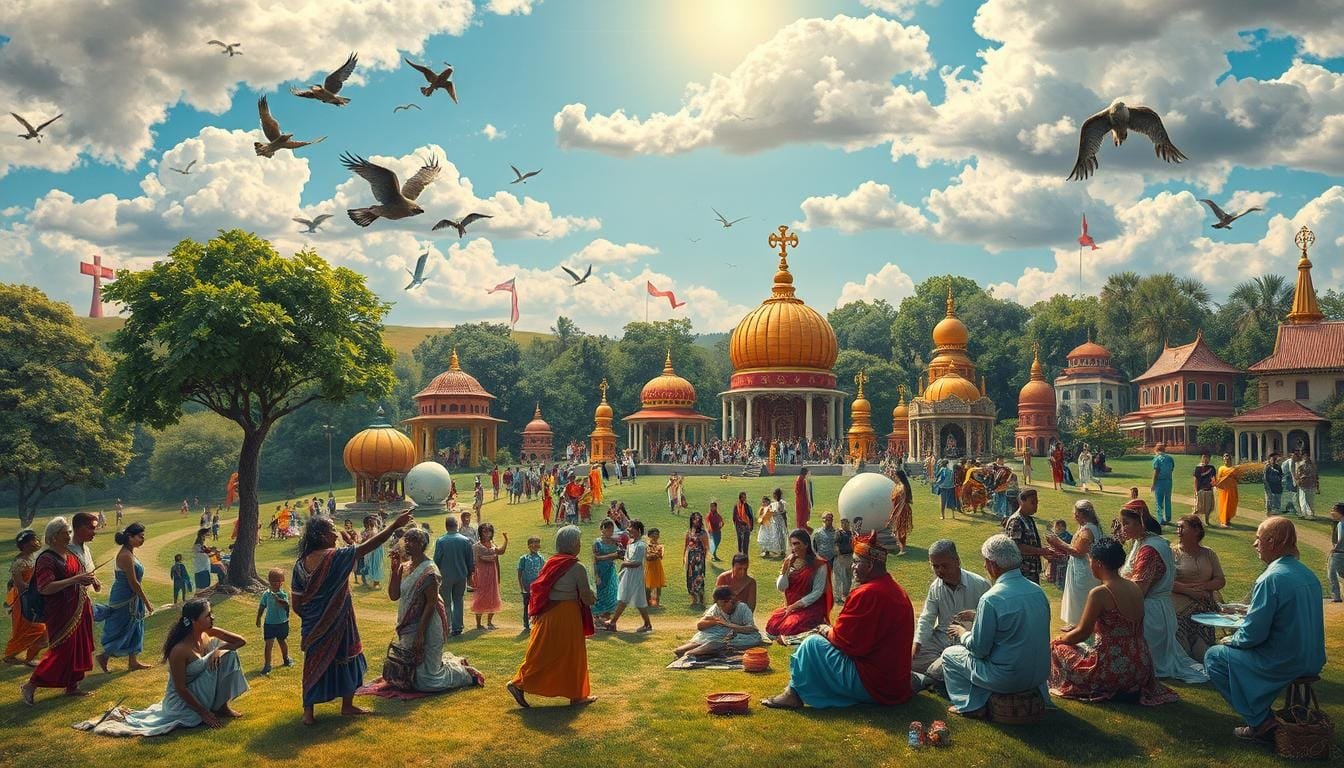Have you ever thought about whether culture can stay vibrant without religion? This pressing question examines if cultures can survive without religious foundations as the world becomes more secular. In the U.S., over half the population doesn’t attend church services often. Many Christians are also moving away from traditional Bible views.
This change leads to a big question: can culture grow and flourish without religion’s influence? Or is religion vital for keeping a culture’s unity and identity?
We’re diving into the deep relationship between culture and religion, looking at the past and current trends. We’ll explore how societies without strong religious ties maintain their cultural identity. Despite religion’s fading role, Christianity’s cultural effects are still strong, especially during big holidays.
This shows a complex connection between faith and daily life. Let’s find out if culture can indeed prosper without leaning on religion.
Key Takeaways
- More than half of Americans don’t go to church regularly, showing a trend toward less religious society.
- A lot of Christians are rethinking traditional Bible interpretations, affecting how religion shapes culture.
- Even with less religious influence, secular societies keep evolving culturally.
- The idea of “Post-Christendom” points to changing values and different moral sources in society.
- Religious beliefs and rituals have always brought people comfort and unity.
- Cultural and religious practices have influenced each other for thousands of years.
- As the role of religion changes, secular societies might find new ways to define their culture and norms.
The Intersection of Culture and Religion
Culture and religion intertwine in ways that shape our society. They form our personal identity and how societies function. Religion guides customs, ethics, and norms with its beliefs and rituals. Culture provides the setting for these religious expressions.
Defining Culture and Religion
Understanding religion and culture means looking at their unique features. Religion comes with beliefs about the divine and sets moral rules. Culture is made up of a group’s shared behaviors, knowledge, and arts.
Religion has influenced culture throughout history. Practices, holidays, and traditions show how they mix. An example is how Australian Aborigine teens take part in puberty rituals, based on their beliefs.
Historical Context and Evolution
The way civilizations have mixed religion and culture is fascinating. Leaders like Moses in Judaism and Siddhartha Gautama in Buddhism have led changes in both. They’ve influenced cultural norms and religious practices.
The clash of cultures during the Crusades and the creation of places like the Vatican show religion’s cultural impact. Art and architecture, and traditions like Japan’s Shinto “Hatsumode,” shape our practices. They fulfill both social and religious roles.
Today, technology is impacting this evolution. Digital tools and virtual reality are making it easier to explore religious texts and sites. This helps preserve our cultural and religious history.
Interfaith talks are also important. The 2001 UNESCO declaration on cultural diversity highlights this. Events like Louisville’s ‘Festival of Faiths’ teach us about and bring different cultures together.
The Role of Religiosity, Spirituality, and Secularism
In today’s world, the mix of religiosity, spirituality, and secularism shapes who we are. It tells us how these forces work in cultures and affect what we believe. This understanding is key to seeing their impact on society.

Understanding Religiosity and Spirituality
Religiosity leads the way in setting cultural standards and values. A survey found 70% of believers think a higher power gives moral direction. This shows many rely on religious rules rather than their own judgment. Around 65% feel without such guidance, people could lose their way.
Being part of a religious group involves spiritual practices. These include praying, meditating, and going to church. A study on migrant African women with HIV/AIDS showed many turned more to their faith after getting diagnosed. This shows that challenges can deepen one’s spiritual life.
Secularism and Its Impact on Culture
Secularism has changed traditions and values in society. Secular people prefer staying away from religious influence, with all surveyed wanting no part in it. Thus, culture is changing, moving away from old religious morals.
Secular folks often join groups not tied to any religion, with 60% active in such communities. This shows a move from religious gatherings to secular ones for moral support. This shift towards secular spaces shows a new way people find community.
Youth today are becoming less religious, which ties to more secular actions. Research links less religiosity with more chance of drinking or smoking among the young. As secular thought rises, the social framework changes from one focused on faith to more secular views.
More Americans now say they follow no religion, rising from 14% to 22% between 2000 and 2016. While some Christian groups see fewer members, over half still fully believe in God. Yet, their religious actions might be less visible than before.
Case Studies: Multi-Ethnic Coexistence and Harmony
Exploring how different ethnic and cultural groups live together in peace teaches us a lot. Qinghai, a province in China, is a great example of how diverse communities can create a unified culture. We will look into case studies that show how cultural harmony can happen, both locally and worldwide.
Qinghai: A Model of Harmony in Diversity
A study published on May 23, 2018, in the International Journal of Anthropology and Ethnology dives into Qinghai’s ethnic and cultural blending. This research, viewed over 41,000 times, studies cultural mixing in the area. It points out how the local cultures have influenced each other from July to October 2006.
It talks about how Han families have adopted Tibetan ways over generations, especially in Daowei township. The study looked at language, religion, marriage, lifestyle, and ethnic identity to understand this mixing.
In Qinghai, people live by the idea that “you are inseparable from me, and I am inseparable from you.” This shows how deep their cultural bond is. Qinghai shows us how different groups can mix their cultures peacefully, offering lessons for the wider world.

Global Perspectives on Cultural Integration
Looking beyond Qinghai, places like Malaysia show how cultures can come together. About 25% of Malaysians are Chinese, and nearly 8% are Indian Malaysians. The country celebrates a mix of holidays, showing a spirit of goodwill since 1957.
“Mamak stalls” in Malaysia offer foods mixing Malaysian, Indian, and Chinese influences. They also speak a blend of languages. While Islam is the state religion, Malaysia embraces various faiths, showing a way to live together despite differences.
In countries like India, Brazil, and Egypt, cultural blending sometimes happens by force. Yet, this mixing has created rich, multicultural identities. Historical examples from China, during the Tang and Song Dynasties, show how different beliefs like Confucianism, Daoism, and Buddhism can coexist, building a society that respects many traditions.
| Region | Ethnic/Cultural Groups | Integration Highlights |
|---|---|---|
| Qinghai | Han, Tibetan, Hui | Tibetanisation and Islamisation processes, mutual cultural enrichment |
| Malaysia | Malay, Chinese, Indian | Celebration of diverse festivals, muhibbah spirit, multilingual environment |
| India | Hindu, Muslim, Sikh, Christian | Multicultural interactions, imposed integration, rich cultural identity |
| Brazil | Indigenous, African, European | Blended cultural practices, syncretism in religion and art |
| Egypt | Arab, Nubian, Coptic | Historical coexistence, shared cultural heritage, diverse religious practices |
Could Culture Survive Without Religion?
We’re looking into if a culture can last without religion. We consider thoughts from philosophy, sociology, and history. This covers both the idea of cultural survival and real-life effects.
Theoretical Perspectives
Culture often uses religion for shared values and identity. John Adams said the U.S. Constitution needs a moral, religious people. George Washington also said religion and morality support political success. These ideas show culture needs some religious or moral base.
As faith’s influence lessens, people wonder about cultural strength in a global setting. The “communities of character” idea is getting attention. When moral systems weaken, society’s unity might too. Studies find existential crises are more common in non-religious societies.
Practical Implications
When religion fades, cultures either adapt or face problems. For example, the U.S. sees more drug issues and crime as community morality drops. People fear a moral decline, thinking we’re heading toward a “new Dark Age.”
Yet, traditions like secular Christmas and Hanukkah keep community ties strong. This shows culture can evolve without religion. Events like Darwin Day show new ways to bring people together.

Data shows religious societies often see less violence and more community work. This means religious morals help keep society together. The losses from less religion are clear from these facts.
Christopher and Peter Hitchens debated if civilization needs God. This topic is still hotly discussed today. To dive deeper, check the full debate at the Pew Forum on Religion & Public Life here.
Conclusion
We’re wrapping up our exploration of culture and religion. They are deeply connected. The Pew Research Centre found that 76.2% of Europeans are Christian. This shows religion’s big role in cultural identity and society’s values. The Crusades are historical examples of how religion both united and divided societies.
According to the World Economic Forum, religious populations will grow a lot by 2050. They’ll grow faster than the non-religious. This tells us religion will keep being important for cultural strength. It helps support groups that other institutions might not. But, we should also think about secular countries like Sweden and Japan. They do well in many social and economic areas, showing a path of cultural growth without religion.
Even though more people say they’re “not religious,” religion and culture still depend on each other. Religion often leads to better health and stronger families. This improves societal well-being. As cultures change, the relationship between religion and secularism sparks discussions. By understanding how religion and culture connect, we can better prepare for the future’s cultural changes.
FAQ
Can culture thrive without religion?
This question looks into if culture can last without religion. It checks out how societies with no religious base keep their unique ways and identities.
What is the intersection of culture and religion?
The intersection of culture and religion is about how they mix and affect each other. They play big roles in shaping how societies grow and how people see themselves.
How are culture and religion defined?
Culture is made up of the traditions, beliefs, art, and actions that define a society. Religion is mainly about organized belief systems and worship, often focusing on a supreme being or god.
What is the historical context and evolution of culture and religion?
Over time, culture and religion have grown together. Religious beliefs have deeply influenced traditions, morals, and norms. This has happened across different civilizations from old times to today.
What are religiosity and spirituality?
Religiosity shows how much religion influences a person’s life. Spirituality is broader, covering personal beliefs in a higher purpose or connection. It may or may not relate to organized religion.
How does secularism impact culture?
Secularism keeps religion out of civic matters. This can change traditional cultural ways, moral values, and social norms. It happens as people move away from religious groups.
What are some examples of multi-ethnic coexistence and harmony?
Qinghai province stands out for its mix of ethnicities and religions living together in peace. This creates a stable, united culture. Around the world, there are similar stories of cultures and religions blending successfully.
How can culture survive without religion?
Can culture last without religion? This is looked at both theoretically and practically. It focuses on our needs for structure and identity. It also looks at how cultural systems change in societies without religion.
